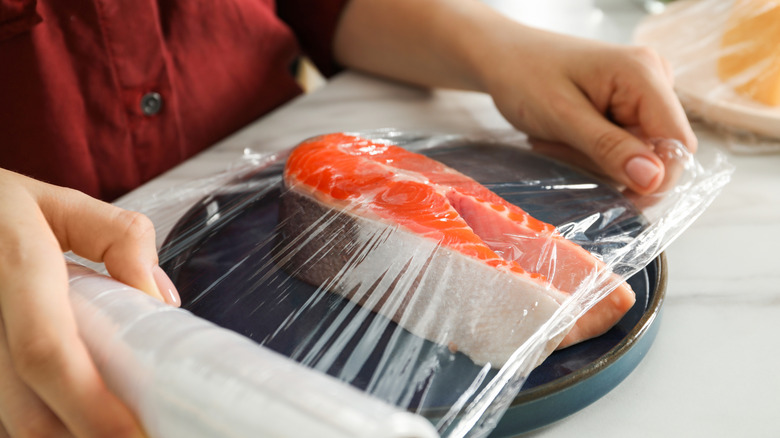The Genius Way Gordon Ramsay Keeps Plastic Wrap From Sticking To Itself
We may receive a commission on purchases made from links.
Many professional and home cooks have a love-hate relationship with plastic wrap. As useful as it is in food prep and food storage, it can be unbelievably frustrating to work with. Plastic wrap is susceptible to static cling, and it tends to fold over on itself as soon as you tear it from its roll. The thin plastic is not easy to unstick, and before you know it, you might go through sheets and sheets of it before you get one to cooperate and lay flat. But it doesn't have to be this way. Just take it from globally-recognized chef Gordon Ramsay. Fans know that every time he prepares his signature dish, beef Wellington, he works with plastic wrap. And to win the battle against cling, Ramsay first moistens the cutting board where he lays the wrap. The plastic then clings to the moisture of the board, not to itself.
Ramsay's tip isn't just for making a juicy beef Wellington you can enjoy for days. You can use this method no matter why you need the plastic wrap. For example, if you are portioning out meat or chicken in plastic for the week, dab some water on your work surface first. The same goes if you are wrapping pie dough or any other food for storage; You can even wrap individual pieces of sushi for freezing. The point is, once the plastic wrap lays flat, you can wrap anything you want in it, with the power to fold up the ends when you're ready.
Other ways to prevent sticky plastic wrap
While Gordon Ramsay's moisture method keeps your plastic wrap from clinging to itself, it's not the only way to keep it from behaving badly. Some are storing their wrap in the freezer instead of the pantry or a drawer, claiming that the cold temperature keeps the plastic manageable. If it does bend over on itself, it's easy to unfold.
Like so many others, I, too, sometimes ended up in a tizzy trying to neatly tear off a square of plastic wrap. Finally, I tried buying a different brand that was installed with a cutter and not a serrated edge. It allows me to pull whatever size of wrap I need out of the box, and then run the cutter across to separate it from the rest of the roll. I haven't had nearly as many problems with static cling using this brand, although it's a tad more expensive than those with serrated edges.
Finally, you can consider whether you really need to use plastic wrap at all. While using foil for baking isn't the best idea, in other cases, a piece of aluminum foil will work just as well as plastic wrap, and it is much easier to handle without it folding up and sticking to itself. One sustainable, washable option is a product like Bee's Wrap Reusable Beeswax Food Wraps. You can often find it in various sizes or rolls that you can cut yourself. You can wrap up foods just as you would with plastic wrap but you won't have to battle the cling; The wrap will only stick to itself at your discretion, from the heat of your hands.

